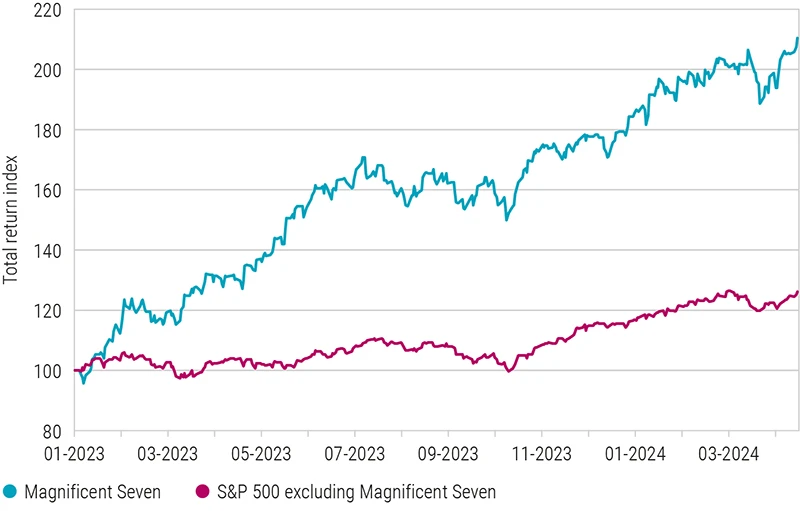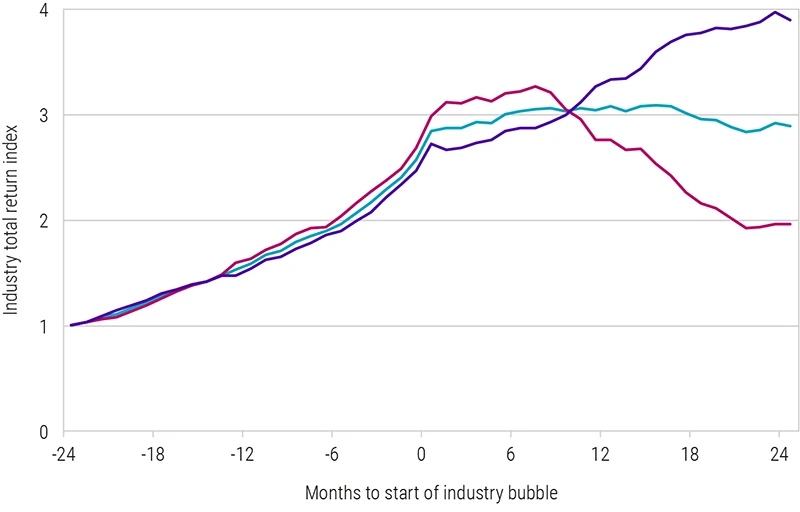In financial markets, bursting bubbles are frequently characterized by irrational exuberance, where investors drastically overestimate future earnings growth or simply buy assets due to a fear of missing out. Classic bubbles see a spectacular rise in valuations and asset prices only to ‘burst’ as fundamentals catch up to the speculative hype and prices plummet.
In contrast to conventional thinking, Swinkels and van der Welle argue that some bubbles can be entirely rational, especially when investors rightly anticipate the extraordinary growth of a paradigm-shifting technology in the real economy.1 They call these ‘buzzing bubbles’ because their strong price increases and high valuations are largely justified.
“
Buzzing bubbles are characterized by strong price increases and high valuations that are largely justified
Since AI took center stage in early 2023, the Magnificent Seven2 have outperformed the S&P 500 by around 80%. Rocketing prices and valuations are understandably stoking concerns of a tech equity bubble. Are concerns warranted and if so, should investors be bracing for a spectacular burst or a beneficial buzz?
Figure 1: Performance of the Magnificent Seven versus the rest of the US market

Source: Robeco, LSEG Datastream, S&P 500.
Rebased price index of Magnificent Seven and the S&P 500 index excluding the Magnificent Seven.
Typical bubble phases
Bubbles often begin with an overly optimistic sentiment that a new era has begun and that the old rules no longer apply. Recall the low interest rate environment of the Great Financial Crisis of 2008 or the dot-com boom of the nineties. Whatever the initial cause, they tend to follow the same pattern: valuations and stock prices rise as early entrants generate large profits. Higher valuations lure more competitors. Investor sentiment and capital flows surge, fueling a self-perpetuating loop. Even informed investors can get caught in the mayhem, abandoning better judgement to follow popular wisdom in the hopes that a bubble has further to run.
This crazed phase is followed by a ‘Minsky moment’.3 Animal spirits are replaced with the collective realization that the rally is overextended and that stocks are massively overvalued. Panic begins sending fearful investors stampeding toward the exit. The market crashes and asset prices correct. Cyclical stagnation ensues and investors are left despondent and calling for more regulation.
By now, most investors agree that bubbles are bad. But the authors challenge that notion showing not every bubble is created equal. Although crashes are preceded by price run-ups and expensive valuations, it would be a mistake to take this evidence and conclude that most price run-ups lead to crashes.
“
It would be a mistake to take this evidence and conclude that most price run-ups lead to crashes
クレジットに関する最新の「インサイト」を読む
ロベコのニュースレター(英文)に登録し、最新のインサイト記事をいち早くご覧ください。環境に配慮したポートフォリオ構築にも役立つ情報をお届けします。
Some bubbles burst others buzz
Building on previous academic research and nearly a century’s worth of US stock data spanning 49 industries, the authors identified 51 industry bubbles in US equity markets from (see Figure 2, blue line).4
Studying their aftermaths, only half of these ended in a burst – defined as a drawdown in returns of more than 40% in the two years following an industry’s stock-price run (Figure 2, magenta line). Examples include utilities (1929), gold (1980), software (1999), and steel (2007). Buzzing bubbles on the other hand, experienced a similar two-year run up in prices but saw no subsequent price drawdown in the two-years following. In fact, returns continued to rise (Figure 2, green line).
Initially, there is little to distinguish between bursting and buzzing bubbles as they expand. However, things get interesting at month nine, where bubble behavior diverges. Bursting bubbles begin to lose a bit of steam, ultimately ending with negative return of about 30% in the two-years following. Returns of buzzing bubbles continue upwards gaining an additional 50% positive return.
Figure 2: Bubbles exhibit different behavior

Source: Robeco, Kenneth French Data Library, Greenwood, Shleifer, and You (2019).
The graphic displays industry price run-ups and subsequent performance from US industries from 1926-2024. The blue line indicates the average rebased price index of 51 detected industry-wide bubbles. Of these 23 saw a maximum drawdown of at least 40% (magenta) in the two years that followed, and 28 that did not experience such drawdown (purple).
Other bubbling indicators
While interesting and to some extent comforting to know not all bubbles end badly, investors still need more surrounding indicators to help define what kind we may be approaching. The run-up data from Figure 2 sheds a bit more light, revealing that industry price bubbles that burst tend to have stronger price run-ups compared to buzzing varieties (200% versus 160%).
Moreover, investor optimism is also much higher with bursts than buzzes (77% vs 53% of the median value) coinciding with high market-wide valuations.5 And while valuations are expensive at the start of any bubble compared to the general market average (22.5 vs 18.8), they are even higher for bursts compared to buzzes (23.5 vs 21.6).6
In the absence of bubbles, the probability of a 40% drawdown for an industry within a two-year period is about 13%, but that probability more than triples (45%) when a bubble starts.
So while bubbles can’t be used to precisely predict future returns, they do predict higher equity risks!
Should investors brace for a burst or expect a buzz?
So, are we in a rational or irrational bubble? Ultimately, while there are definitely signs that we are currently in a bubble with an increased risk of a sell-off in the medium term, it is by no means a certainty that we are in a bursting bubble when it comes to technology stocks.
The average two-year run-up return of bursting bubbles is close to 200%, far higher than we have observed today (around 80%). And while the US tech sector is expensive, it’s not exceptionally so based on historical figures. Likewise, overall market sentiment is high (60%), but once again not exceptionally so. Sentiment was far larger during bust periods (77%). News flows specific to technology stocks are substantially above the market average, but not more than usual.
So what should investors do given the circumstances?
One way to keep broad equity market exposure but reduce the probability and severity of a drawdown is to allocate to low-risk assets, preferably those with good momentum, high quality, and attractive valuations. This may come at the cost of missing out on a bubble that keeps on buzzing but will likely reduce the pain in case of a correction.
This article is an excerpt of a special topic in our five-year outlook.
Footnotes
1The history of financial bubbles is described in more detail in: O’Hara (2008), Goetzmann (2016), Engsted (2016), and Quinn and Turner (2023).
2Apple, Amazon, Alphabet, Microsoft, Meta Platforms, Nvidia, and Tesla
3Named for American economist Hyman Minsky, whose research characterized stages of credit cycles and how they lead to financial crises.
4Following the Greenwood, Shleifer, and You (2019) definition of bubbles: a price that has gone up by 100% and has had an outperformance relative to the broader stock market index of 100%, both over the past two years.
5Source for the NYT sentiment index: https://www.hakholm.com/nyt-sentiment-index
6Valuations are calculated using cyclically adjusted price/earnings (CAPE) ratios.
Webinar: 5-Year Expected Returns 2025-2029
Our five-year outlook on market opportunities and risks.
重要事項
当資料は情報提供を目的として、Robeco Institutional Asset Management B.V.が作成した英文資料、もしくはその英文資料をロベコ・ジャパン株式会社が翻訳したものです。資料中の個別の金融商品の売買の勧誘や推奨等を目的とするものではありません。記載された情報は十分信頼できるものであると考えておりますが、その正確性、完全性を保証するものではありません。意見や見通しはあくまで作成日における弊社の判断に基づくものであり、今後予告なしに変更されることがあります。運用状況、市場動向、意見等は、過去の一時点あるいは過去の一定期間についてのものであり、過去の実績は将来の運用成果を保証または示唆するものではありません。また、記載された投資方針・戦略等は全ての投資家の皆様に適合するとは限りません。当資料は法律、税務、会計面での助言の提供を意図するものではありません。 ご契約に際しては、必要に応じ専門家にご相談の上、最終的なご判断はお客様ご自身でなさるようお願い致します。 運用を行う資産の評価額は、組入有価証券等の価格、金融市場の相場や金利等の変動、及び組入有価証券の発行体の財務状況による信用力等の影響を受けて変動します。また、外貨建資産に投資する場合は為替変動の影響も受けます。運用によって生じた損益は、全て投資家の皆様に帰属します。したがって投資元本や一定の運用成果が保証されているものではなく、投資元本を上回る損失を被ることがあります。弊社が行う金融商品取引業に係る手数料または報酬は、締結される契約の種類や契約資産額により異なるため、当資料において記載せず別途ご提示させて頂く場合があります。具体的な手数料または報酬の金額・計算方法につきましては弊社担当者へお問合せください。 当資料及び記載されている情報、商品に関する権利は弊社に帰属します。したがって、弊社の書面による同意なくしてその全部もしくは一部を複製またはその他の方法で配布することはご遠慮ください。 商号等: ロベコ・ジャパン株式会社 金融商品取引業者 関東財務局長(金商)第2780号 加入協会: 一般社団法人 日本投資顧問業協会

